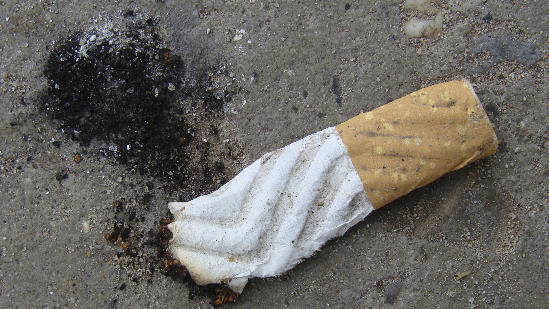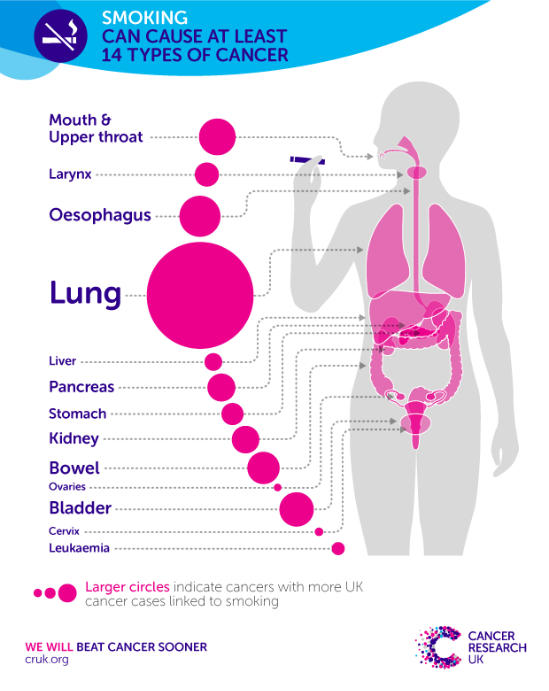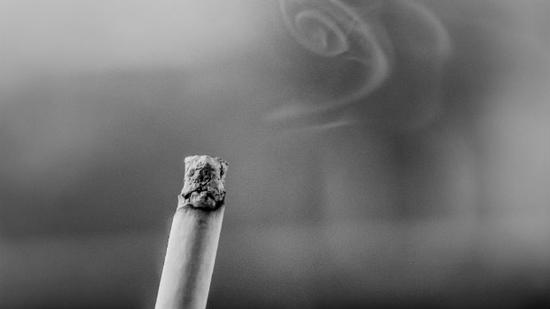
Smoking is by far the biggest preventable cause of cancer. Thanks to years of research, the links between smoking and cancer are now very clear. Smoking accounts for more than 1 in 4 UK cancer deaths, and nearly a fifth of all cancer cases.
The good news is that many of these deaths are preventable, by giving up smoking. Speak to your GP or pharmacist, or visit the NHS Smokefree(link is external) pages for free advice and support to give you the best possible chance of quitting.
Which cancers are caused by smoking?
Chemicals in cigarette smoke enter our blood stream and can then affect the entire body. This is why smoking causes so many diseases, including at least 14 types of cancer, heart disease and various lung diseases.

Smoking causes more than 4 in 5 cases of lung cancer. Lung cancer has one of the lowest survival rates of all cancers, and is the most common cause of cancer death in the UK.
Smoking also increases the risk of at least 13 other cancers including cancers of the mouth, pharynx (upper throat), nose and sinuses, larynx (voice box), oesophagus (gullet or food pipe), liver, pancreas, stomach, kidney, bowel, ovary, bladder, cervix, and some types of leukaemia Smoking could increase the risk of breast cancer, but any increase in risk is likely to be small.
More information about different cancer types.
What influences the risk of cancer from smoking?
Smokers have a much higher risk of lung cancer than non-smokers, whatever type of cigarette they smoke. There’s no such thing as a safe way to use tobacco.
Filters and low-tar cigarettes make little difference – your lung cancer risk is not lower compared to smokers of average cigarettes. This may be because smokers tend to change the way they smoke in order to satisfy their nicotine craving, for example by taking bigger puffs or smoking more cigarettes.
The more cigarettes you smoke a day, the higher your risk of cancer. If you aren’t able to quit completely, cutting down the number of cigarettes you smoke a day can be a good first step. Even light or social smoking can harm your health so keep trying to stop entirely.
Scientists have found that the number of years you spend smoking affects your cancer risk even more strongly than the number of cigarettes you smoke a day. For example, smoking one pack a day for 40 years is even more dangerous than smoking two packs a day for 20 years.
The serious damaging effects of smoking cannot be cancelled out by leading an otherwise healthy lifestyle, like keeping fit and eating healthily. The best way to reduce your risk is to give up smoking completely(link is external).
How does smoking cause cancer?
The main way that smoking causes cancer is by damaging our DNA, including key genes that protect us against cancer. Many of the chemicals found in cigarettes have been shown to cause DNA damage, including benzene, polonium-210, benzo(a)pyrene and nitrosamines.
This is already bad news, but it’s made worse by other chemicals in cigarettes. For example chromium makes poisons like benzo(a)pyrene stick more strongly to DNA, increasing the chances of serious damage. And chemicals like arsenic and nickel interfere with pathways for repairing damaged DNA. This makes it even more likely that damaged cells will eventually turn cancerous.
Smokers are also less able to handle toxic chemicals than those with healthy lungs and blood. Chemicals in cigarette smoke make it harder for smokers to neutralise or remove toxins, and can make their immune systems less effective too.
How long does it take for smoking to cause cancer?
It usually takes many years, or decades, for the DNA damage from smoking to cause cancer. Our bodies are designed to deal with a bit of damage but it’s hard for the body to cope with the number of harmful chemicals in tobacco smoke. Each cigarette can damage DNA in many lung cells, but it is the build up of damage in the same cell that can lead to cancer. However research has shown that for every 15 cigarettes smoked there is a DNA change which could cause a cell to become cancerous. This is why it’s better to give up smoking sooner rather than later.
http://www.cancerresearchuk.org/about-cancer/causes-of-cancer/smoking-and-cancer/how-to-stop-smoking
Breathing in other people’s smoke, also called second-hand smoke, can cause cancer. Passive smoking can increase a non-smoker’s risk of getting lung cancer by a quarter, and may also increase the risk of cancers of the larynx (voice box) and pharynx (upper throat).
Second-hand smoke can cause other health problems too. Every year, second-hand smoke kills thousands of people in the UK from lung cancer, heart disease, stroke and the lung disease Chronic Obstructive Pulmonary Disease (COPD).
How does second-hand smoke affect children?
Second-hand smoke is particularly dangerous for children. Children exposed to passive smoke are at higher risk of respiratory infections, asthma, bacterial meningitis and cot death. Second-hand smoke has been linked to around 165,000 new cases of disease among children in the UK each year.
For children, the majority of exposure to second-hand smoke happens in the home. Smoke can spread throughout the home, even if you open the windows. Almost 85 percent of tobacco smoke is invisible and smoke particles might also build up on surfaces and clothes, although the impact of this is not yet clear. If you are a smoker, smoking outside can help reduce your child’s exposure.
Is smoking in cars bad for passengers’ health?
Second-hand smoke can reach very high levels inside cars because it is a small enclosed space.
During your journey, children in the backseat will be exposed to average smoke levels around three times the European recommended air pollution limit. But the level varies depending on how much you smoke, if you have all the windows fully open or air con on. Peak levels can reach as much as 35 times this limit.
Since 1 October 2015 it has been an offence to smoke in a vehicle carrying anyone under the age of 18 in England(link is external) and in Wales(link is external).
Does second-hand smoke contain dangerous chemicals?
There are 2 types of tobacco smoke:
- Mainstream smoke, which is directly inhaled through the mouth end of the cigarette
- Sidestream smoke, which comes from the burning tip of the cigarette
Second-hand smoke is made up of sidestream smoke and exhaled mainstream smoke, mixed with the surrounding air.
Sidestream smoke is about 4 times more toxic than mainstream smoke, although people inhale it in a more diluted form. This is because sidestream smoke contains much higher levels of many of the poisons and cancer-causing chemicals in cigarettes, including:
- At least 3 times as much carbon monoxide
- 10-30 times more nitrosamines
- Between 15–300 times more ammonia
What’s in a cigarette?

You may think a cigarette is just tobacco wrapped in paper, but it’s much more than that. When a cigarette burns it releases a dangerous cocktail of over 5,000 different chemicals. Many of these chemicals are poisonous and more than 70 may cause cancer, according to the International Agency for Research on Cancer (IARC). And it’s not just the smoker who is exposed to these chemicals, because there are also high levels in the smoke coming off the tip of a cigarette while it burns. So anyone around the smoker breathes them in as well.
This page has information on some of the poisons in cigarette smoke that we know are linked to cancer. To learn more about the impact of these chemicals in the body, see our How smoking causes cancer page.
Chemicals can get into cigarettes in different ways. Some are found naturally in the tobacco plant, some are absorbed by the plant from the soil, air or fertilisers, and some are formed when tobacco leaves are processed or are added by the tobacco industry. Others form when a cigarette burns, so are only present in the smoke coming off a cigarette.

Many of the cancer-causing chemicals in tobacco and cigarette smoke have other suprising uses too:
- Benzene – an industrial solvent, refined from crude oil
- Arsenic – a poison, used in wood preservatives
- Cadmium and lead – used in batteries
- Formaldehyde – used in mortuaries and paint manufacturing
- Polonium-210 – a highly radioactive element
- Chromium – used to manufacture dye, paints and alloys
- 1,3-Butadiene – used in rubber manufacturing
- Nickel – used to protect metals from corrosion
- Vinyl chloride – used to produce plastic and vinyl products
- Beryllium – used in nuclear reactors
- Ethylene oxide – a disinfectant used to sterilise hospital equipment
- Polycyclic aromatic hydrocarbons – a group of dangerous DNA-damaging chemicals, including benzo(a)pyrene
- Ortho-Toluidine – used in the production of weedkillers
- 4-aminobiphenyl and 2-naphthyl-amine – used in dye manufacturing until it was banned in the EU
And then there are tobacco-specific nitrosamines – a group of cancer-causing chemicals only found in tobacco.
This cocktail of chemicals is why there is no safe way to use tobacco and the best thing a smoker can do for their health is to stop smoking completely.
The free Stop Smoking Services help thousands of people quit every year, so if you are looking for the best possible chance of success, talk to your doctor or pharmacist or visit NHS Smokefree(link is external).
Shisha and other types of tobacco

Tobacco can be used in many different forms – but all are linked to cancer. There is no safe way to use tobacco.
Other tobacco products aren’t safer than cigarettes
Tobacco can be used in many different forms – but all are linked to cancer. There is no safe way to use tobacco.
- Cigars and pipes are known to increase the risk of many cancer types including lung, mouth and upper throat, food pipe (oesophagus), voice box (larynx) and stomach. Smoking these products is just as bad for you as smoking cigarettes.
- Roll-up tobacco contains the same cancer-causing chemicals as manufactured cigarettes. Roll-up cigarettes aren’t any safer than regular cigarettes
- Smoking bidis, the most common form of tobacco in South Asian communities, also causes the same types of cancer as other tobacco products such as cigars.
Does smokeless tobacco increase cancer risk?
Smokeless tobacco includes a wide variety of products which can be used in different ways, chewed (‘dry chewing tobacco’), sucked (‘moist oral tobacco’) or inhaled (‘nasal snuff’). Scientists have shown that many forms of smokeless tobacco increase your risk of mouth, oesophageal (food pipe) and pancreatic cancers.
Most smokeless tobacco products in the UK are used by South Asian communities. In these communities, dry chewing tobacco is often used as part of a ‘betel quid’ or ‘paan’. These consist of a mixture of betel nut (or areca nut), slaked lime and various herbs and spices, wrapped in a betel leaf.
Betel nut itself can cause cancer, so chewing betel quids can cause mouth cancer even if no tobacco is added.
Most types of smokeless tobacco contains at least 28 different chemicals that can cause cancer. Smokeless tobacco users can be exposed to similar, if not higher, levels of cancer-causing tobacco-specific nitrosamines (TSNAs) and nicotine than cigarette smokers. So, like cigarettes, smokeless tobacco is both dangerous and highly addictive.
Does shisha increase cancer risk?
Many people think shisha is harmless but this is not the case – shisha contains tobacco. Shisha, also called hookah or waterpipe, smokers inhale flavoured tobacco through a long pipe attached to a water bowl. Shisha smokers still inhale toxic cancer-causing chemicals and addictive nicotine.

Unlike cigarettes, shisha is burnt using charcoal so users can also be exposed to dangerously high levels of the poisonous gas carbon monoxide. Levels of carbon monoxide in the body from smoking shisha can be up to 17 times higher than from cigarettes and can cause carbon monoxide poisoning.
Looking at all the evidence together suggests that smoking shisha could at least double your risk of lung cancer and may be linked to some other cancer types.
Does snus increase cancer risk?
Snus is a special type of smokeless tobacco that is used in Sweden. It is banned in most other countries in the EU. Snus is manufactured using a special process that considerably lowers the levels of TSNAs in the finished product. Because of this, snus may be less dangerous than other types of tobacco.
But it still contains these cancer-causing chemicals at a low level. Snus use has been linked to pancreatic cancer, but not mouth or lung cancer.
It is possible that snus could be used specifically to help hardcore smokers, who are unlikely to quit through other means, to stop smoking altogether. But so far the evidence is uncertain and the International Agency for Research on Cancer has concluded that smokeless tobacco should not be recommended for quitting smoking.
http://www.cancerresearchuk.org/about-cancer/causes-of-cancer/smoking-and-cancer/smoking-facts-and-evidence